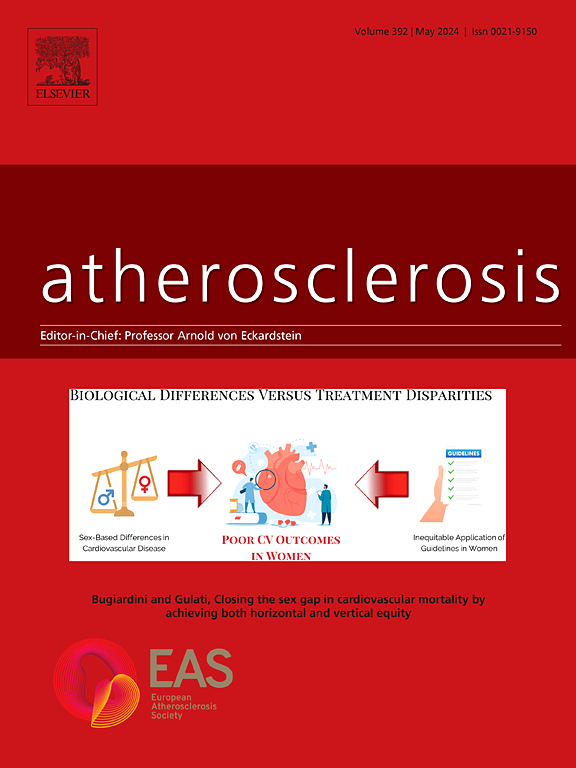英国生物银行中基于机器学习的冠状动脉疾病代谢标志物的评估。
IF 4.9
2区 医学
Q1 CARDIAC & CARDIOVASCULAR SYSTEMS
引用次数: 0
摘要
背景和目的:利用机器学习和来自电子健康记录的临床数据建立的冠状动脉疾病(ISCAD)的计算机定量评分,已被证明可导致亚临床动脉粥样硬化、冠状动脉疾病(CAD)后遗症和死亡率的风险分级。大规模代谢物生物标志物分析为疾病预测和分级的机器学习提供了更高的可移植性和客观性。然而,这些模式并没有被充分利用。我们从代谢组学数据训练的机器学习模型的概率中评估了CAD的定量评分。方法:我们开发了一个cad预测学习模型,使用来自英国生物银行(UK Biobank)的93,642人的代谢数据(中位数[IQR]年龄,57亿岁;男性39796人(42%);5640[6%]诊断为CAD),并评估其作为CAD定量代谢风险评分的可能性(M-CAD;范围从0[最低概率]到1[最高概率])。评估M-CAD与动脉僵硬指数、射血分数、冠心病后遗症和死亡率的关系。结果:该模型预测CAD的受者-工作特征曲线下面积为0.712。M-CAD每增加0.1,动脉硬度指数增加0.19,射血分数下降0.2%。在M-CAD四分位数中,心肌梗死的发生率和复发性均逐步增加(与MI的发生率和复发性四分位数相比,前四分位数的优势比分别为15.3[4.2%]和12.5[0.2%])。同样,全因死亡率、CVD相关死亡率和CAD相关死亡率的风险比和患病率在M-CAD十分位数中逐步增加(与全因、CVD和CAD死亡率的前十分位数相比,前十分位数分别为2.98[14%]、9.34[4.3%]、26.7[2.7%])。结论:基于代谢的机器学习可用于建立与动脉粥样硬化负担、CAD后遗症和死亡率相关的CAD定量风险评分。本文章由计算机程序翻译,如有差异,请以英文原文为准。

Evaluation of a machine learning-based metabolic marker for coronary artery disease in the UK Biobank
Background and aims
An in silico quantitative score of coronary artery disease (ISCAD), built using machine learning and clinical data from electronic health records, has been shown to result in gradations of risk of subclinical atherosclerosis, coronary artery disease (CAD) sequelae, and mortality. Large-scale metabolite biomarker profiling provides increased portability and objectivity in machine learning for disease prediction and gradation. However, these models have not been fully leveraged. We evaluated a quantitative score of CAD derived from probabilities of a machine learning model trained on metabolomic data.
Methods
We developed a CAD-predictive learning model using metabolic data from 93,642 individuals from the UK Biobank (median [IQR] age, 57 [14] years; 39,796 [42 %] male; 5640 [6 %] with diagnosed CAD), and assessed its probabilities as a quantitative metabolic risk score for CAD (M-CAD; range 0 [lowest probability] to 1 [highest probability]) in participants of the UK Biobank. The relationship of M-CAD with arterial stiffness index, ejection fraction, CAD sequelae, and mortality was assessed.
Results
The model predicted CAD with an area under the receiver-operating-characteristic curve of 0.712. Arterial Stiffness Index increased by 0.19 and ejection fraction decreased by 0.2 % per 0.1 increase in M-CAD. Both incident and recurrent myocardial infarction increased stepwise over M-CAD quartiles (odds ratio (OR) 15.3 [4.2 %] and 12.5 [0.2 %]) in top quartiles as compared to the first quartile of incident and recurrent MI respectively). Likewise, the hazard ratio and prevalence of all-cause mortality, CVD-associated mortality, and CAD-associated mortality increased stepwise over M-CAD deciles (2.98 [14 %], 9.34 [4.3 %], 26.7 [2.7 %] in the top deciles as compared to the first decile of all-cause, CVD, and CAD mortality respectively).
Conclusions
Metabolic-based machine learning can be used to build a quantitative risk score for CAD that is associated with atherosclerotic burden, CAD sequelae and mortality.
求助全文
通过发布文献求助,成功后即可免费获取论文全文。
去求助
来源期刊

Atherosclerosis
医学-外周血管病
CiteScore
9.80
自引率
3.80%
发文量
1269
审稿时长
36 days
期刊介绍:
Atherosclerosis has an open access mirror journal Atherosclerosis: X, sharing the same aims and scope, editorial team, submission system and rigorous peer review.
Atherosclerosis brings together, from all sources, papers concerned with investigation on atherosclerosis, its risk factors and clinical manifestations. Atherosclerosis covers basic and translational, clinical and population research approaches to arterial and vascular biology and disease, as well as their risk factors including: disturbances of lipid and lipoprotein metabolism, diabetes and hypertension, thrombosis, and inflammation. The Editors are interested in original or review papers dealing with the pathogenesis, environmental, genetic and epigenetic basis, diagnosis or treatment of atherosclerosis and related diseases as well as their risk factors.
 求助内容:
求助内容: 应助结果提醒方式:
应助结果提醒方式:


